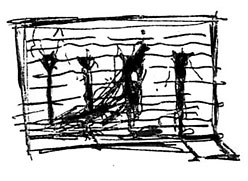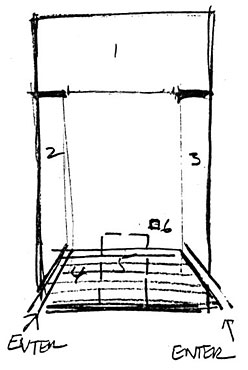

Robert Wilson: the CIVIL warS and After
There was a priest who was asked by a family to conduct a funeral service. The family was very poor and they told him, “We don’t have a lot of money. How much does a funeral cost?” And the priest said, “I can give you a ten dollar service, a six dollar service, a four dollar service or a fifty-cent service. What kind of funeral do you want?” “Well, ten dollars is so much for us to pay, but can you tell us what it’s like?” And the priest said, “It’s a very good service. It’s very sad, everyone will cry. I will cry and so will everyone in the room.” And the family said, “Ten dollars is so much money. What’s a six dollar service like?” The priest said, “The six dollar service is good too, very good. Everyone’s going to cry, except me.” And the family said, “Six dollars is so much. What’s the four dollar service like?” “It’s a good service, too. Half the people are going to cry and the other half aren’t.” “Four dollars is so much money. What’s the fifty-cent service like?” “Oh, it’s a good service,” said the priest, “a real good service. Half the people will cry and the other half will laugh.” And I said, “That’s what I want, a fifty cent King Lear!” I got a letter from my Lear the other day, the man who’s going to play it in Hamburg. I met him in Munich when I was doing The Golden Windows. He’s a great comedian. He lives in a mental institution most of the time. He used to live two months in and two months out. He was working at the Residenz Theater when I met him and he came to rehearsals with his psychiatrist. Anyway, his face seems right for it and he’s a great, great comedian — he knows how to get laughs.
I can see why Brecht might have wanted a comedian for Lear, why do you?
Lear is the most tragic of Shakespeare’s plays, yet it also has the possibility of being comic. I just came into the humor of it.
You’re scheduled to begin work on the production in Los Angeles this spring.
Yes, I’ll be doing a two-week workshop at U.C.L.A. with students. I’m only a little into it at this point but I’ve already decided what the décor will be. I’ve been given a big T.V. studio and I’m going to hang a sky and make a floor of various materials such as coal and rocks and maybe a series of platforms. So the space will look something like that. I’ve cast a lot more people than there are roles so I may have four or five people as Cordelia or Lear with different people doing different parts at different times. I may have one actor as Lear on rock here or another over here listening to a part of the text on the radio. I may also have a giant puppet of Lear at the back or maybe someone simply reciting the text on one side of the stage and an image that relates to Lear on the other. It will really be more like a reading. The presentation will also be very formal as all my works are. I don’t see the play in a naturalistic way. I hate naturalism. One of the problems is that none of the actors I’ll be working with are really right for what I want. Their training is all wrong. They don’t know how to speak simply. They want to interpret, they want to express the meanings of the text. That doesn’t interest me at all. I just want to hear the text. I want it to be like when I read King Lear at home for myself. I read it one night and it says one thing and I read it a week later and it says something else. But I’m not trying to interpret it. I’m just listening to the words and thinking about them. And that’s how I’d like to present Lear in Los Angeles. To present, not interpret — because as soon as you start interpreting, it becomes closed and boxed-in. I’m also beginning work on Death Destruction & Detroit #2, a new play for the Schaubühne in Berlin. The last one was about Rudolf Hess but this one’s going to be a life of Kafka. The structure is the same as the first D D & D, sixteen scenes with the first eight scenes mirroring the second eight, and with each one a mirror of a corresponding scene in the first D D & D (1979). I designed a space for the work the other night and this is what it looks like.
I’m going to have six different stages. There’s be a proscenium stage at one end of the room (1), two narrow shadow stages along the sides (2,3) and then an informal stage made up of steps at the back (4) with entryways on either side. The audience will sit in the middle on swivel chairs. There’ll also be an overhead bridge or balcony (5) and an elevator that can move up and down through the stage floor (6)—you know, they just installed an elevator in Spandau for Hess.
This will be the firs time you’ve worked in an environmental situation since The $ Value of Man back in 1975.
Right. What I like about the space is that you can have an actor here (1) and one very high up here (5) and another under the floor (6). You can have a dialogue between all parts of the room. You have a very formal stage at one end of the space and then at the other an informal situation with people sitting on the steps. One is sort of Brechtian and one is very Robert Wilson. Here, I’ll show you what I put together the other night. We begin with a prologue in front of a wall just like in D D & D. It’s an image I’ve been thinking about in different ways — people building a wall, people contained by a wall, the wall of China, the wall at Spandau. In the first scene I want to have two big parrots on a swing over the heads of the audience and a woman in a red dress passing below. I have this image of a red woman sucking on the wounds of a child and suffocating on the blood. Here’s a line I’m going to use: “Have faith in the text.” I’m just beginning to collect texts now. For the second scene, I’m thinking of having four couples, maybe two on the formal stage traveling on a train from Prague to Berlin, another two mountain climbing on the shadow stages, two more waiting for a ceremony on the steps and maybe somebody on the bridge who’s going to jump and somebody here digging a grave (6). For the next scene, I want a small Jewish village, like something out of Chagall with people dancing or praying and maybe Rudolf Hess comes out and puts a blank piece of paper on a wall, and at the end of the scene, somebody goes and writes something on it. Then comes a scene in Hell with someone blowing a whistle forcing the damned back to work. Later there’ll be a mirror scene in the sky. I have so many different images in my head: a man trapped in a cage, a thunderstorm like in D D & D, a black panther with big thick paws crawling on one of the shadow stages towards a forest clearing on the main stage, a traffic jam with fog and all these paralyzed cars — it’ll be the same scene where we had racing cars in the desert in D D & D, then a scene with mountain peaks where everyone who’s looking for something will end up and later on, two horses on the main stage who explain what’s happening. The final scene will be the traffic jam again. Kafka wrote a beautiful parable about this big green monster who had no feet, so I’m going to have these big green monsters without feet making their way through the traffic jam. The epilogue will be back in front of the wall and I think I’ll just have Hess and Kafka standing there talking to themselves.
